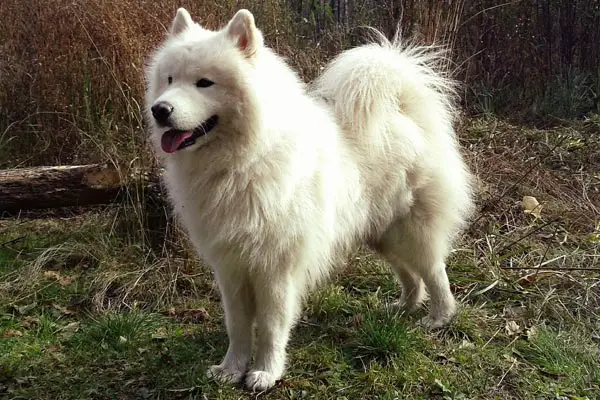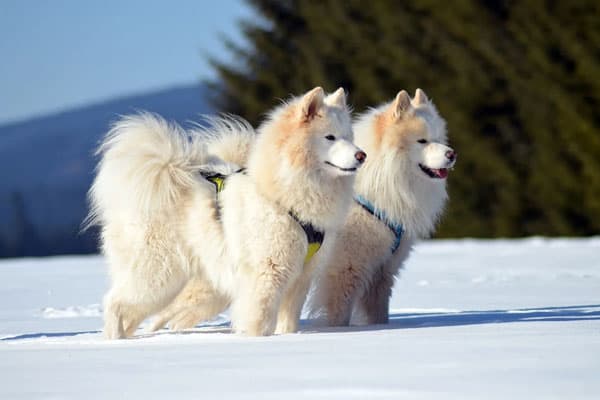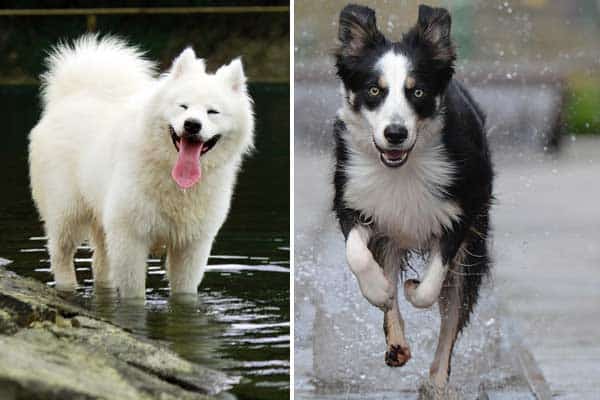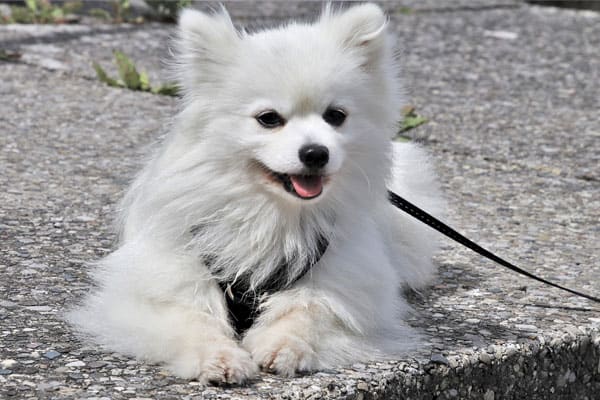Are Samoyeds Good With Other Dogs: Why These Dogs Enjoy Canine Company

The Samoyed is a very unique and incredibly ancient dog breed. Just one glance at a Samoyed and you will likely think “oh, there’s a sled dog.”
And in fact, the Samoyed is a sled dog breed. But these dogs don’t just pull sleds, historically speaking. They are also amazing at hunting, herding, and protecting.
Because many canine jobs that Samoyeds are good at require dog teams, this means the Samoyed as a breed is quite likely to enjoy canine as well as the human company.
But you can also have a lot of influence over whether your particular Samoyed is good with other dogs, as we will discuss in detail in this article.
Are Samoyeds Good With Other Dogs?
Samoyeds have a long history as dogs that spend their lives living and working with other dogs. This means the Samoyed can be very good with other dogs.
However, how you make the introductions and supervise the initial interactions will also have a lot to do with whether your Samoyed sees the other dogs as friends or potential prey or competition.
Learn From a Samoyed Owner About Samoyeds With Other Dogs
As you will learn about in this short, useful YouTube video, the Samoyed dog breed may not always look at another dog and instantly think “new friend!”
While these naturally active dogs do often love to play and romp and run with other dogs, you will need to take an active role in making those all-important initial introductions.
If your household also includes different species, such as a family cat, the same holds true. You need to supervise and manage each introduction and supervise playtime until you feel confident the two animals can be left alone safely.
Understanding the Samoyed Running and Chasing Drive
As the American Kennel Club (AKC) explains, a well-trained, well-socialized Samoyed is likely to be friendly, gentle, and adaptable.
This means that, ideally, you can add another dog to the family without incident. You can also theoretically add other family pets or a new baby and have a happy outcome.
But this should not be taken as a given or a guarantee.
As the Samoyed Club of America highlights, the Samoyed has been bred to do specific jobs alongside people. Those jobs include pulling a sled, hunting prey, herding livestock, and protecting people and livestock from predators.
All of these jobs require an intense drive to run and chase. A working Samoyed is on their feet for hours each day, running and jumping and using all senses to detect threats and opportunities.
So it just makes sense that your Samoyed might not instantly look at another dog, a cat, or another family pet and think they are supposed to play nicely together.
This is especially the case if the other animal or dog is smaller and lower to the ground and tends to run fast. Just the sight of another animal doing this may activate your Samoyed’s instinct to give chase.
This is why you will need to be closely involved in the early stages of helping your Samoyed to see these other family pets, whether dogs or cats or other species, as friends and packmates rather than as prey or as threats.
If you do a great job supervising your Samoyed during these critical first meetings, there is a much better chance you will have a happy family that can live peacefully together and enjoys each other’s company.
How to Introduce Your Samoyed to Other Dogs
As Middle the Samoyed dog’s blog explains, it is important to know the steps to take to introduce your Samoyed to other family dogs.
The same holds true if you are introducing your Samoyed to other family pets of different species.
In either case, you can use these steps to make productive and positive first introductions that may in time become lifelong friendships.
Step 1: Choose a neutral place for the first few meets
The big mistake many owners make is to make those all-important first introductions in a space that may provoke territorial or anxious feelings in one or both animals.
An example would be the room where your Samoyed’s crate sits. Your Samoyed may feel very strongly that this is “their” space and may view the other dog as an interloper or a threat.
If it is possible and safe, try to make the very first introductions outdoors with both dogs leashed (you will need a friend or family member to help you with this).
If it is not possible or safe, choose a more neutral area such as a general-purpose family room.
Step 2: Keep the first few meets short and sweet
You can’t inform your Samoyed (or the other animal) in advance that in a few minutes or hours or days they will be getting a new “forever housemate.”
So it is important to remember that, to your Samoyed, the new animal will appear out of the blue in their lives. It will feel very sudden and perhaps threatening or scary.
This makes keeping the first meeting or two short and sweet to give both animals time to get used to the idea of each other.
Aim for five minutes for the first meet, 10 minutes for the second meet, 15 minutes for the third meet, and so on.
While there are some cases where two dogs simply love each other and instantly bond and become best friends, it is important not to count on this happening.
And if it doesn’t, you will need to build up to an hour, then two, then a morning, and so forth, of together time.
Step 3: Supervise every detail of the interactions closely
The goal of each meeting will be to build on the successes of the last meeting while minimizing any negative interactions.
It really helps here if you know at least one of the animals quite well. This will give you additional insight into what body language and vocalizations are telling you.
Having someone else with you so there is one person keeping eyes on each animal can also really help you spot any tiny problems before they become big, scary, and potentially dangerous problems.
Step 4: Step in right away if you see any interaction going south
There may be times when you are not sure if an interaction is going smoothly or not.
In the beginning, if you have any misgivings, go ahead and separate the two animals rather than waiting to see if your instincts are correct or not.
Then you can do a course correction before the next scheduled interaction to nip any small problems in the bud.
Step 5: Come well supplied with positive reinforcements
Treats, praise, pats, and more treats are always a great way to encourage two animals who are both bonded with you to like each other as well.
However, do your best not to involve dog toys or other favored items unless they are new to both animals.
Step 6: Give your Samoyed a good workout first
As the Animal Health Clinic explains, a tired Samoyed is more likely to be a friendly, gentle Samoyed, especially if the situation involves a sudden and dramatic change.
Step 7: Involve a professional canine trainer if this helps
The Samoyed is not the easiest dog breed to train and socialize even for very experienced dog trainers.
These dogs are just very unique in their lineage and their history. They have high intelligence, but that intelligence often manifests in shows of stubbornness and independent thinking.
Sometimes the best way to introduce your existing dogs to a new dog is to involve a neutral third party such as a professional canine trainer.
A perk of choosing this route is that you get to learn from watching the trainer interact with both of your dogs so that if you decide to add a third dog to your family later, you will already know what to do.
How to Plan for Adding a Samoyed to Your Multi-Dog Family
After reading through the seven steps in the previous section here, it is easy to see that you may need to plan ahead to add another dog to your multi-dog family.
As VetStreet explains, the Samoyed is a dog breed that definitely has the potential for getting along peacefully with other family pets.
But you don’t want to leave anything to chance. The truth is, anytime you change something in a dog’s daily routine, be it their food, their bedding, or their playmates, there will be an adjustment period.
If you can plan to make the introductions over about a week of time, this will help ease the transition for all of your animals and give them some time to get used to the idea of sharing you.
This is the best way to help all your dogs be friends.





